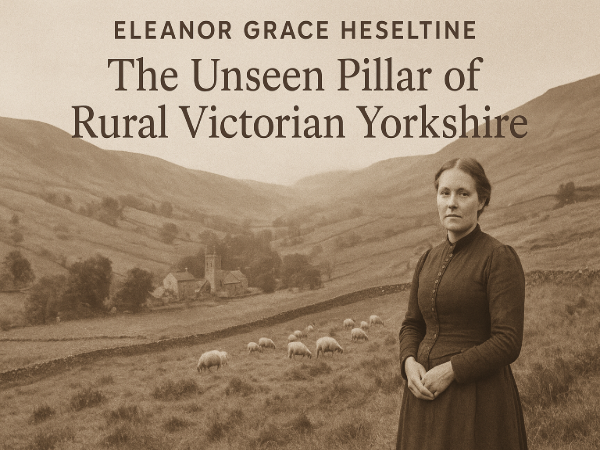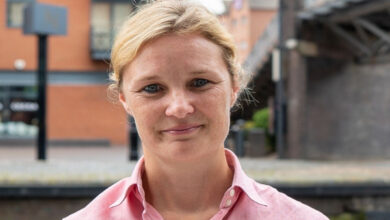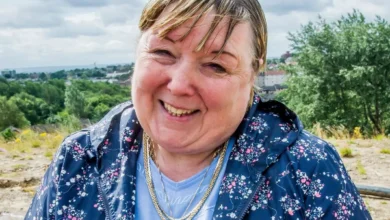Eleanor Grace Heseltine: The Unseen Pillar of Rural Victorian Yorkshire
A remarkable life story of resilience, community, and the untold legacy of women in the 19th-century English countryside

Eleanor Grace Heseltine, born in 1865 in the rural parish of Melbecks, North Yorkshire, lived a life emblematic of countless Victorian women whose contributions to their communities went largely undocumented. Though absent from national headlines, she played an essential role in the social and cultural fabric of the Yorkshire Dales, a region shaped by close-knit agricultural life, Methodist faith, and generational resilience. Today, her story stands as a testament to the enduring influence of ordinary women who were the backbone of rural England.
Introduction
When we think of history, we often picture the lives of kings, queens, political leaders, and celebrated inventors. But the true foundation of any era lies in the quiet lives of those who kept communities thriving behind the scenes. Eleanor Grace Heseltine was one such figure. Born in 1865 in Melbecks, a parish in the heart of the Yorkshire Dales, she lived through a time of change and challenge — from the tail end of the Industrial Revolution to the dawn of the 20th century. Her life story, though preserved only in parish records, gravestones, and local memory, offers a window into the resilience, faith, and dedication of rural Victorian women.
The Early Life of Eleanor Grace Heseltine
Eleanor entered the world in 1865, in Melbecks — a place where the landscape itself shaped the lives of its inhabitants. Surrounded by rolling green hills, windswept heather, and stone-built villages, the Yorkshire Dales was both a place of beauty and hard work. Her parents, William Heseltine and Margaret Heseltine, were part of a long line of Yorkshire families whose livelihoods were tied to farming, lead mining, and the seasonal rhythms of the land.
Life in rural Victorian England was far from easy. Children grew up with responsibilities from an early age, often contributing to household work or assisting in family trades. For Eleanor, the values of hard work, thrift, and community loyalty were instilled from her earliest years — values that would define her adult life.
Melbecks in the Victorian Era
To understand Eleanor’s life, we must understand Melbecks in the late 19th century. The parish encompassed small settlements like Gunnerside, Low Row, and Feetham. These were not bustling market towns but quiet farming villages, deeply connected to Methodist traditions. The chapel was not only a place of worship but also a hub of social interaction, education, and moral guidance.
The 1860s and 1870s were decades of gradual change. While industrial cities like Leeds and Manchester experienced rapid urban growth, places like Melbecks retained much of their traditional character. However, the economic challenges of agriculture, combined with declining local industries like lead mining, meant that many rural families had to adapt to survive.
The Role of Women in Rural Victorian Society
Eleanor Grace Heseltine’s life was shaped by the expectations placed upon Victorian women in rural communities. Marriage, motherhood, and household management were seen as central roles. Yet these tasks were far from passive — they required organizational skill, resourcefulness, and physical endurance.
In households like Eleanor’s, women often managed gardens, preserved food, cared for livestock, and made clothes by hand. They were also the moral compass of the home, instilling religious values and ensuring children were prepared for work or school. Women’s contributions extended beyond the family unit; they participated in chapel events, organized charity efforts, and supported neighbors in times of illness or hardship.
Family and Faith
Eleanor’s faith was almost certainly Methodist, given the dominance of the denomination in the Yorkshire Dales during her lifetime. The Wesleyan Methodist Chapels in the area, including the one in Gunnerside where she would later be buried, played a central role in shaping community values.
Religious life was deeply intertwined with daily living. Sunday was a day of rest, reflection, and gathering, but it also reinforced social bonds. Chapel attendance was expected, and women like Eleanor were often the backbone of these religious communities — teaching Sunday school, preparing chapel teas, and raising funds for maintenance.
The Challenges of the Late 19th Century
The late 1800s brought economic uncertainty to rural Yorkshire. Agricultural prices fluctuated, young people were leaving for better opportunities in industrial cities, and traditional crafts were being replaced by factory-made goods.
For women like Eleanor, these challenges meant adapting to a changing economy while preserving the stability of home life. It also meant maintaining traditions — from local dialect to regional recipes — that connected each generation to the one before it.
A Life Rooted in Community
Although her name does not appear in political records or newspapers, Eleanor Grace Heseltine’s influence would have been felt by everyone in her immediate circle. In villages like Melbecks, every household was connected. People knew each other’s struggles, celebrated each other’s successes, and offered help in times of need.
Oral tradition in such communities often remembered individuals not for grand achievements but for steadfast kindness, reliability, and moral integrity. It is highly likely that Eleanor was remembered for these very qualities.
Death and Legacy
Eleanor Grace Heseltine passed away in 1947, at the age of 82. She was buried in the Gunnerside Wesleyan Methodist Chapelyard — a peaceful resting place among the stone walls and green fields she had known all her life.
Her gravestone, modest yet enduring, stands as a silent marker of a life well-lived. Though she left no political speeches, no published works, and no portraits in museums, her legacy endures in the continuity of community life in the Yorkshire Dales.
Why Stories Like Eleanor’s Matter
History often overlooks people like Eleanor Grace Heseltine, yet it is precisely these lives that sustained the fabric of society. Without women who tended the home, nurtured children, supported neighbors, and upheld community traditions, rural England would have lacked stability during times of upheaval.
In genealogical research, individuals like Eleanor emerge as vital links in family histories. Her life reflects the experiences of millions of women whose names may be recorded only in parish registers, yet whose influence continues through descendants and preserved traditions.
The Broader Context: Rural Women in Victorian England
Eleanor’s story is part of a much larger picture. Across the British Isles, rural women in the Victorian era faced similar realities:
Economic Pressures: Declining rural industries forced families to diversify their income.
Migration: Many younger people left for cities, altering village demographics.
Cultural Preservation: Women acted as keepers of local customs, dialects, and recipes.
Religious Influence: Chapel life provided moral structure and social cohesion.
These shared experiences created a common bond among women across regions, even if they never met.
Preserving the Memory of Eleanor Grace Heseltine
Today, historians, local heritage groups, and genealogists play an important role in preserving stories like Eleanor’s. Archival records, family photographs, and oral histories help ensure that such lives are not forgotten.
By researching Eleanor Grace Heseltine, we gain more than a biography — we gain insight into a way of life that has largely vanished. Her story encourages us to value the contributions of those who may never appear in textbooks but whose work was vital to the survival of their communities.
Conclusion
Eleanor Grace Heseltine’s life may not have been one of fame or public recognition, but it was deeply significant to the people and place she called home. Her years in the Yorkshire Dales were marked by service, resilience, and quiet influence — the hallmarks of countless rural women in Victorian England.
In remembering her, we honor an entire generation of women whose stories deserve to be told. Through the fields she walked, the chapel she attended, and the lives she touched, Eleanor remains a part of Yorkshire’s living history.



